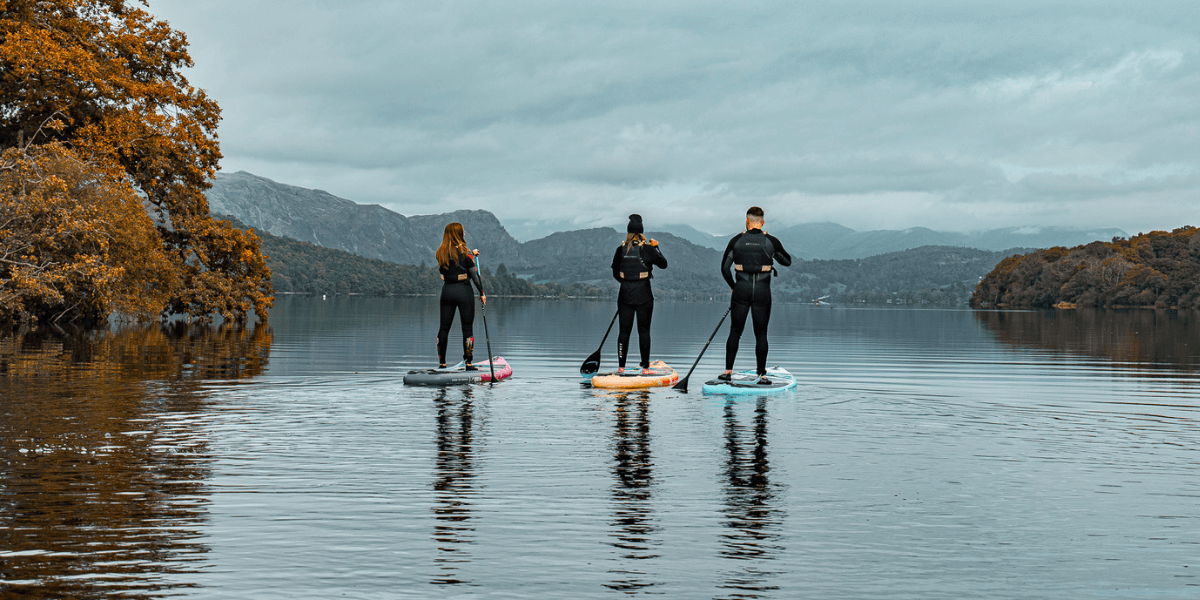
Table of content
Introduction
Paddleboarding in Autumn is great for many reasons like fewer crowd, the air feels fresher and the water is usually calmer!
But while it may feel like nature is winding down for the winter, the opposite is true. Autumn is one of the most active times for wildlife across the UK. Mammals are preparing for the colder months, birds are on the move and the changing light makes every encounter feel that little bit more magical. So whether you're heading down the coastline, along the river or exploring a lake, there's a lot to see if you take a look. Here’s a guide to some of the animals and seasonal changes you might spot while paddleboarding through autumn and how to enjoy them responsibly.
Autumn Wildlife Paddleboarding Essentials
Check the forecast – Wind, tide, and temperature can change quickly in autumn. Aim for calm, settled days.
Dress for the water, not the air – A wetsuit or drysuit, neoprene boots, and gloves help keep you warm if you fall in.
Go early or late – Dawn and dusk are the best times to spot wildlife and enjoy calm conditions.
Know local rules – Check if your route passes through wildlife reserves or restricted areas.
Leave no trace – Take everything with you, including litter.

1. Birds on the Move
Autumn migration is a great spectacle. Millions of birds pass through the UK each year as they head south for the winter, stopping to rest and feed before they carry on. Paddleboarding puts you in the perfect position to watch it all unfold.
Coastal Highlights
If you paddle along the coast, especially around estuaries, salt marshes or sheltered bays you might see flocks of Brent geese, curlews, oystercatchers, dunlins, and turnstones feeding on the shoreline.
In late October, pink-footed geese begin to arrive from Iceland and Greenland forming huge skeins across the skies over Norfolk, Lincolnshire, and Scotland.
You might also see gannets diving offshore or guillemots and razorbills still lingering around cliffs and coastal stacks. On calm days, keep an eye out for small seabirds resting on the water’s surface, auks, scoters, or even puffins if you’re lucky and early in the season.
Inland and Freshwater Birds
If you prefer to paddleboard on rivers and lakes, you’ll still find plenty to watch. Many wintering ducks start arriving from the north, wigeon, pochard, teal, and tufted ducks are common on large reservoirs and lochs. Grebes, cormorants, and swans are regular year-round companions.
On smaller rivers and canals, look for the flash of a kingfisher. That unmistakable streak of turquoise or the elegant poise of a grey heron standing motionless at the water’s edge. You might also see moorhens, coots, and mallards busy feeding among reeds and overhanging branches.
For the best viewing, go early in the morning or late in the afternoon when the light is low and the water is still. Glide gently along banks and avoid sudden movements or splashes.
SUP Products You'll Love
2. Seals, Dolphins, and Coastal Companions
Few things feel more magical than meeting a seal from your paddleboard. Their curious faces often pop up quietly beside you before slipping below the surface again.
The UK is home to both grey seals and harbour seals, and autumn is an especially good time to see them. Grey seals begin their pupping season between late October and early December. If you’re paddling near the coast, especially around known colonies, you might spot them resting on sandbanks or rocky shores.
Key locations include:
Blakeney Point and Horsey Gap in Norfolk
Donna Nook in Lincolnshire
Farne Islands in Northumberland
Moray Firth, Isle of May, and Orkney in Scotland
Isles of Scilly and Cornwall’s north coast
Always give seals plenty of space at least 100 metres and never paddle between them and the shore. If they lift their heads or shuffle towards the water, you’re too close. Respecting distance keeps both them and you safe.
Along parts of the Welsh, Cornish, and Scottish coasts, you might also see harbour porpoises or bottlenose dolphins. Keep your eyes on calm water sometimes they surface quietly before disappearing again just as quickly.

3. Rivers, Lakes, and Lochs: Autumn Encounters
Inland waterways can feel completely transformed by autumn. Misty mornings, falling leaves, and mirror-flat reflections make it an almost meditative experience but they’re also teeming with life.
Otters
If you’re very lucky, you might catch sight of an otter. They’re shy, but early mornings or evenings on quiet rivers and lochs are your best chance. Look for telltale ripples, floating bubbles, or smooth slides down muddy banks. Even if you don’t see one, the signs paw prints or droppings (spraints) tell you they’re around.
Small Mammals
In woodland-fringed areas, you might glimpse red squirrels darting through the trees (particularly in Scotland, Northumberland, and the Lake District).
You’ll also see more fish activity as water temperatures cool and oxygen levels rise trout and perch often feed closer to the surface in autumn.
4. Staying Safe and Comfortable
Autumn brings beauty, but also colder water and unpredictable weather. Keep paddling, but stay prepared:
Dress for the water temperature, not the air temperature. A decent wetsuit or drysuit, neoprene boots, and gloves make a huge difference.
Carry a dry bag with spare layers, a warm hat, and a hot drink.
Check forecasts carefully, especially for wind and tides on coastal routes.
Tell someone your route or paddle with a friend or group when exploring new places.
A little preparation means you can enjoy wildlife watching without worrying about getting too cold or caught out by a sudden change in weather

5. Respecting the Wildlife You Meet
It’s worth saying again: keep a respectful distance from all wildlife. Paddling gives you a unique, peaceful perspective, but even small disturbances can stress animals. A few key points to remember:
Never chase or circle birds or mammals for a closer look.
If you’re near a known seal colony or bird reserve, follow local guidance, some areas restrict access during breeding or pupping seasons.
Avoid loud noises and sudden splashing.
Don’t feed animals or leave litter, even biodegradable food waste.
Record your sightings on apps like iRecord, BirdTrack, or Seasearch, your data helps researchers monitor populations and migration patterns.
Final Thoughts
Autumn might be the most overlooked time to paddleboard, but it’s arguably the most rewarding. The world slows down, the light softens, and nature puts on one last show before winter.
From flocks of migrating geese overhead to seals bobbing curiously beside you, every paddle feels different. There’s a stillness to it a sense of being part of something bigger.
So next time you’re out on the water, take a moment to pause your paddle. Watch the ripples spread out, listen to the quiet calls across the water, and just be there. You might spot a kingfisher, an otter, or nothing more than your own reflection but that’s the beauty of it.
Autumn paddleboarding isn’t about distance or speed. It’s about connection with nature, the season, and yourself.
The season might be cooling off, but the best paddleboard deals of the year are heating up. Keep an eye out for Bluefin’s Black Friday offers your chance to upgrade your setup and make next year on the water even better.

FAQ
1. Is it okay to get close to wildlife while paddleboarding?
No it’s always best to keep a respectful distance. Getting too close can disturb animals, especially during breeding or feeding times. Use binoculars or a camera zoom if you want a closer look, and paddle quietly to avoid stress or alarm.
2. What’s the best time of day to see wildlife from a paddleboard?
Early mornings and late afternoons are ideal. The light’s softer, the water’s calmer, and many animals like otters, kingfishers, and herons are more active around dawn and dusk. You’ll also find fewer people on the water at those times.
3. Can seals approach paddleboarders?
Yes, seals are naturally curious and sometimes pop up near boards to take a look. Stay still and enjoy the moment, but never paddle towards them or block their route back to shore. Keep at least 100 metres away, especially during pupping season (October–December).
4. Do I need permission to paddleboard near wildlife reserves?
In some cases, yes. Certain reserves and estuaries have restricted areas to protect nesting or feeding birds. Check local signage or the reserve’s website before launching, and always follow any seasonal access rules.
5. What should I do if I find injured or stranded wildlife while paddling?
Don’t try to handle it yourself. Move away to avoid causing more stress and contact local wildlife rescue services. For marine animals, call the British Divers Marine Life Rescue (BDMLR) on 01825 765546.
Take your paddleboarding to the next level!
Black Friday is almost here get ready to upgrade your board and gear with our biggest offers of the year.
SUP Products You'll Love





Share:
Bluefin SUP Black Friday Deals 2025:
Common Paddleboarding Mistakes (and How to Fix Them)